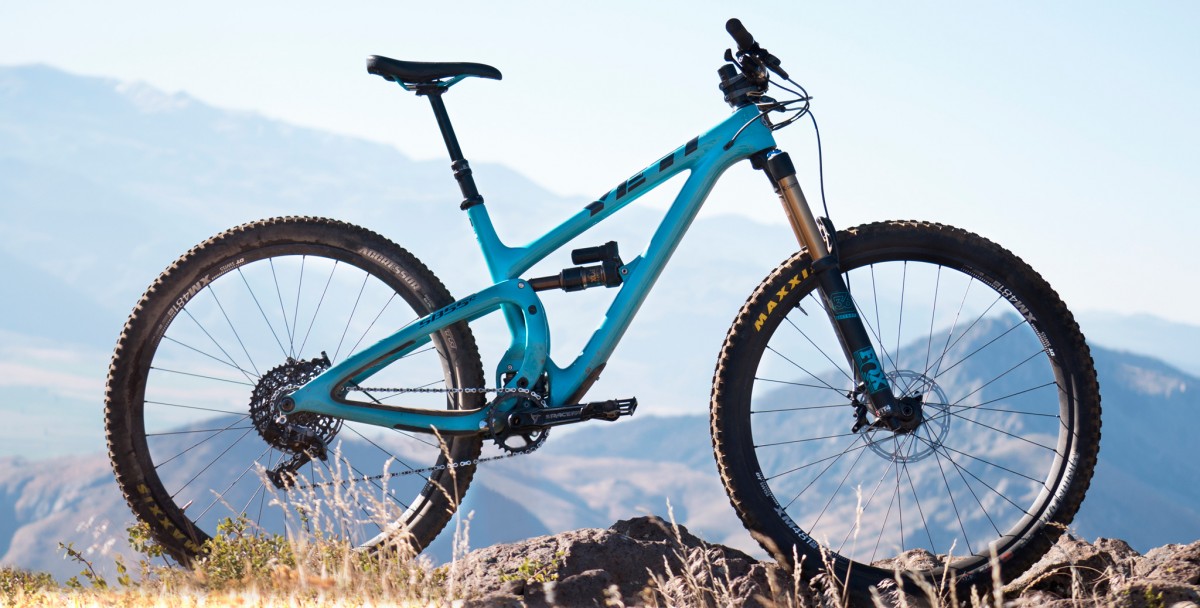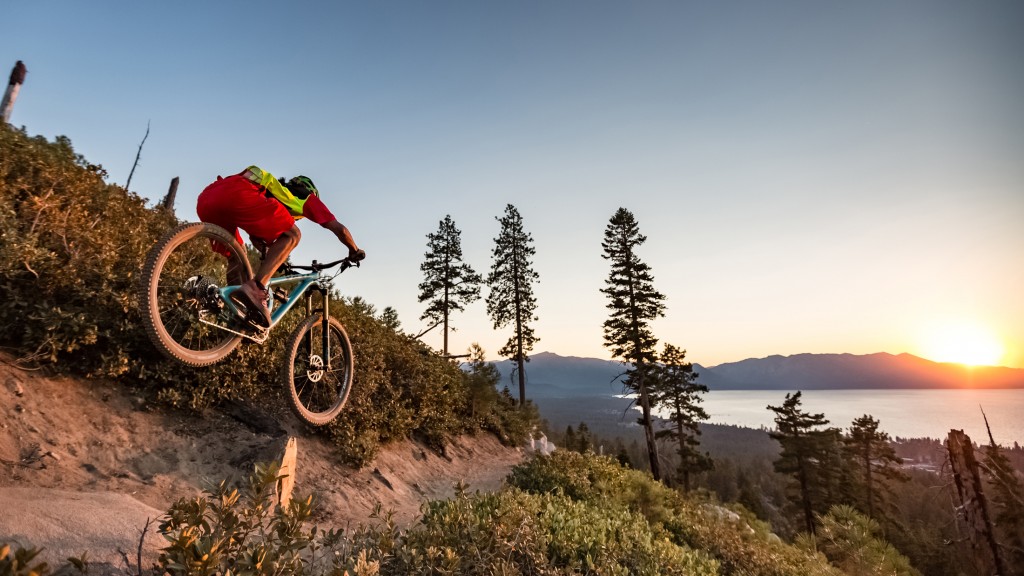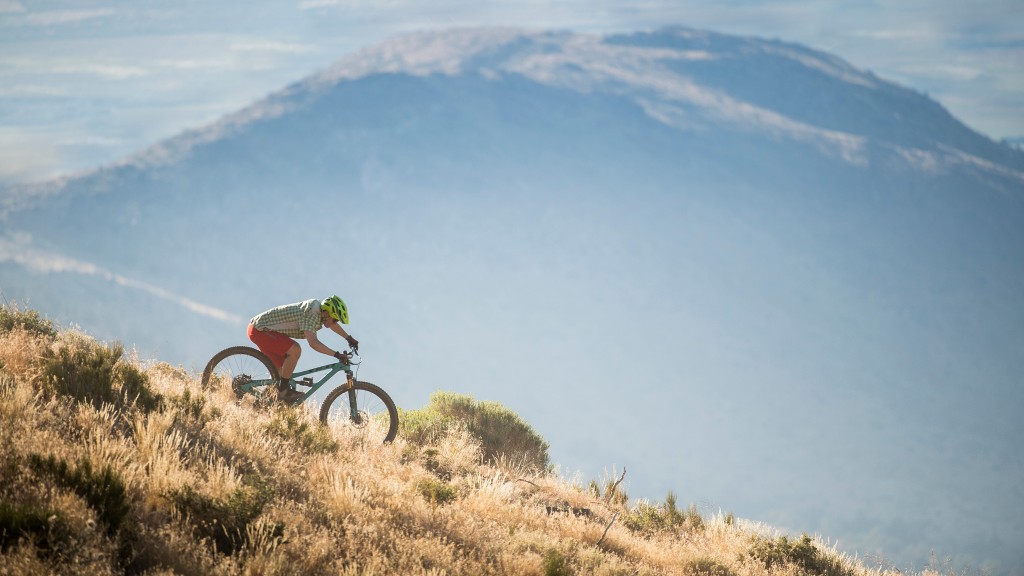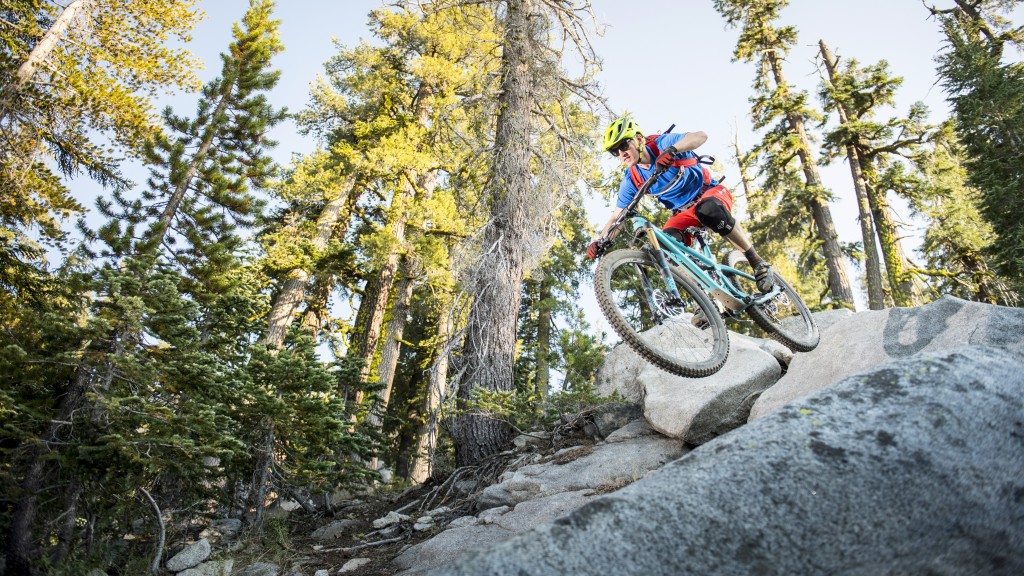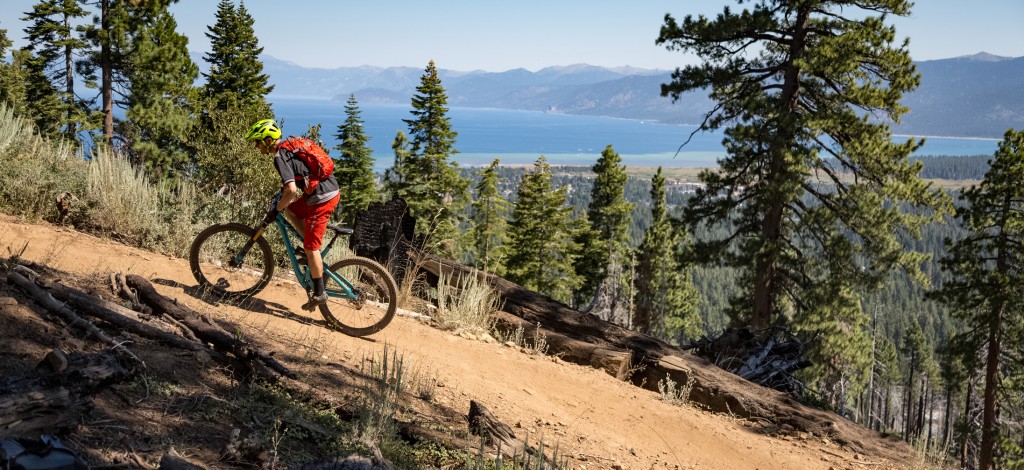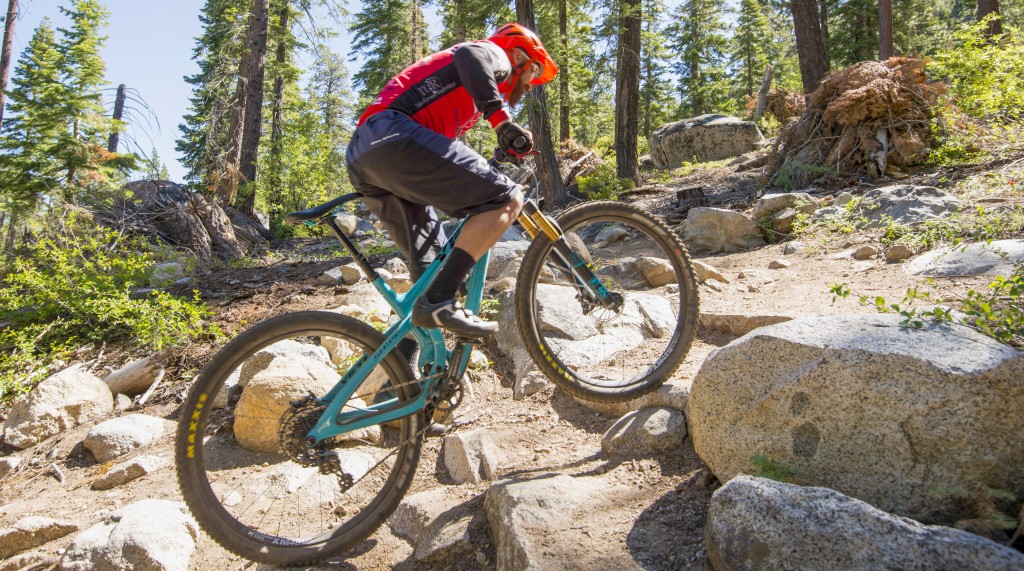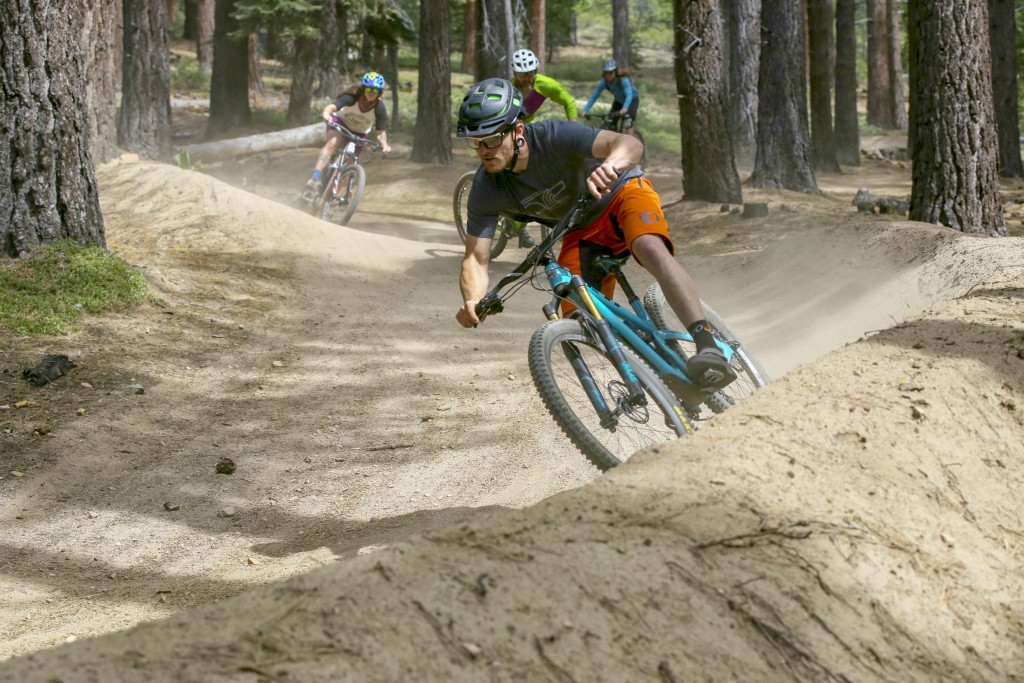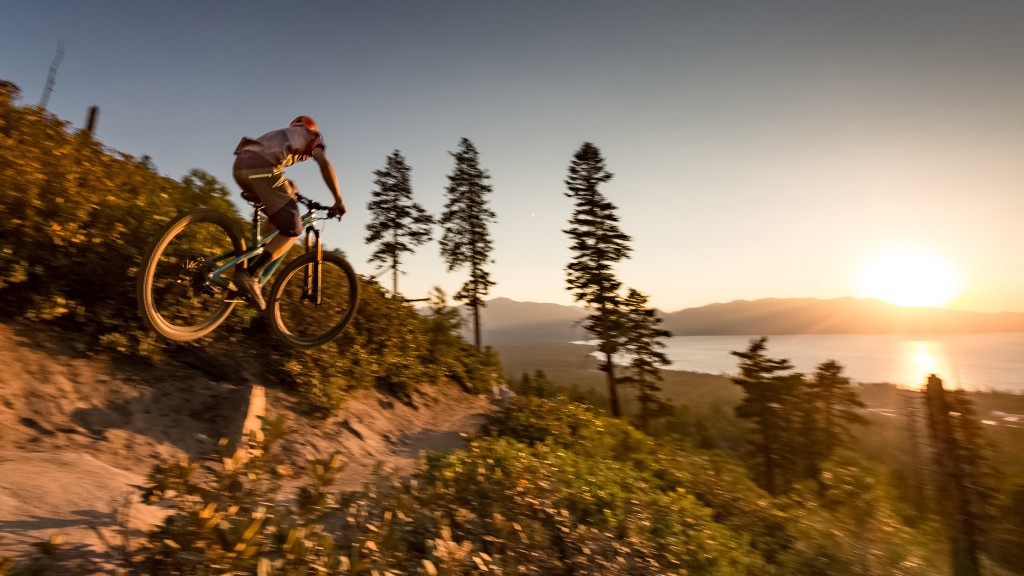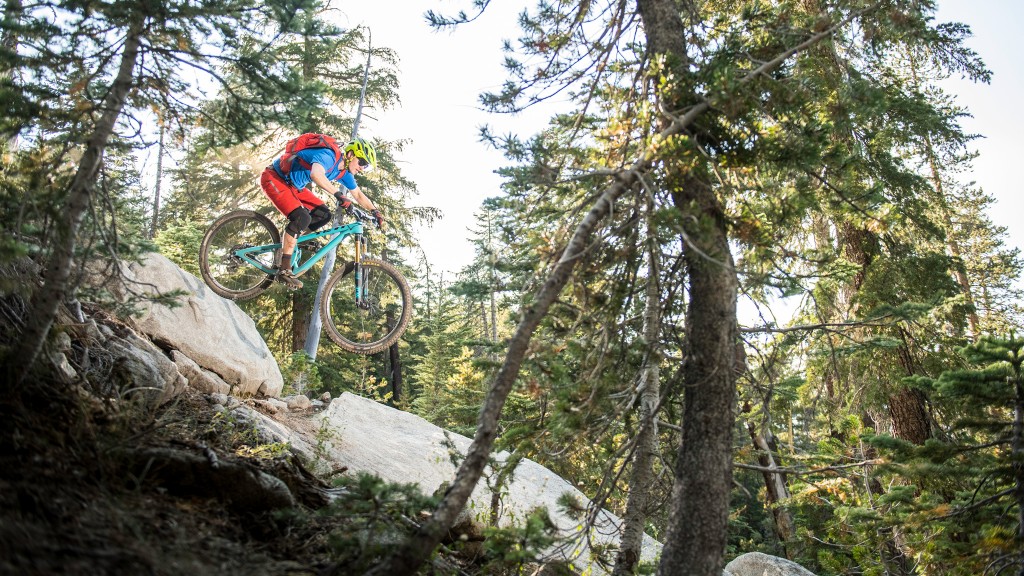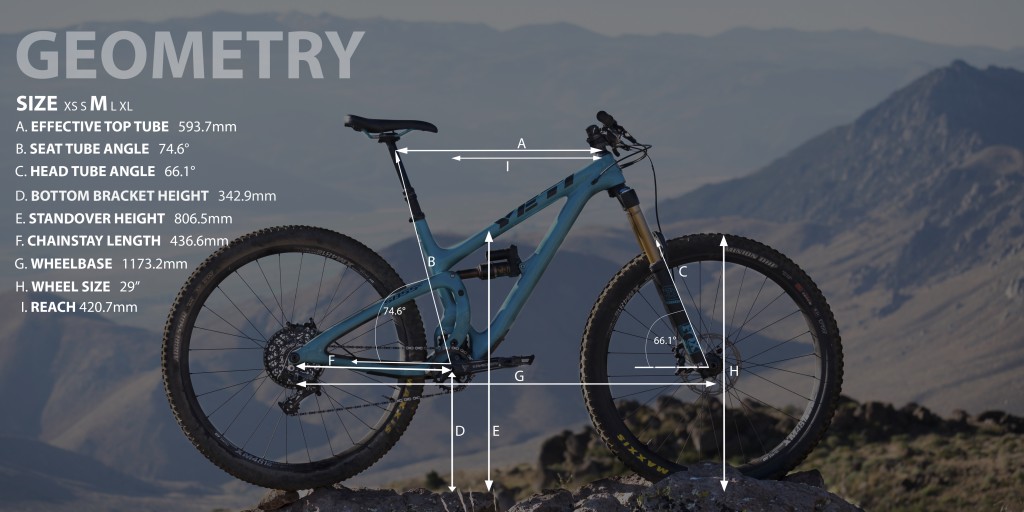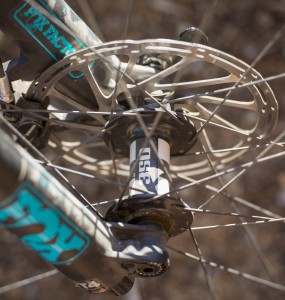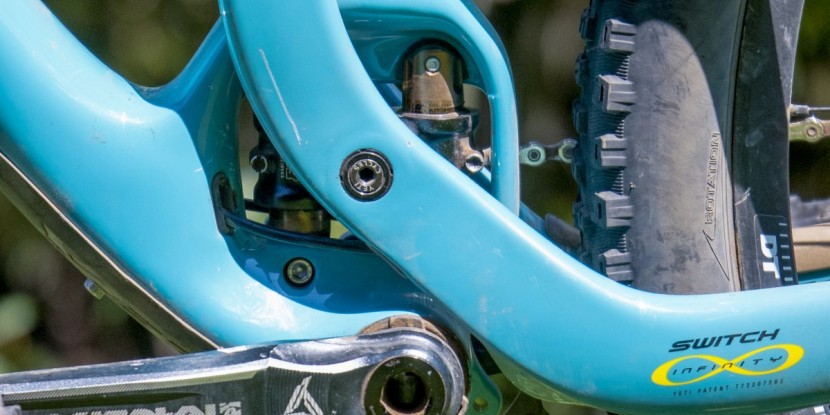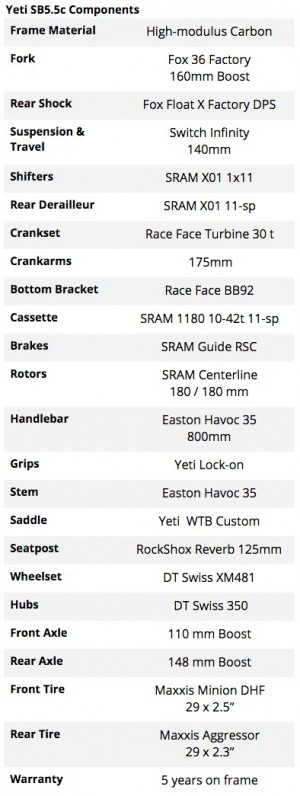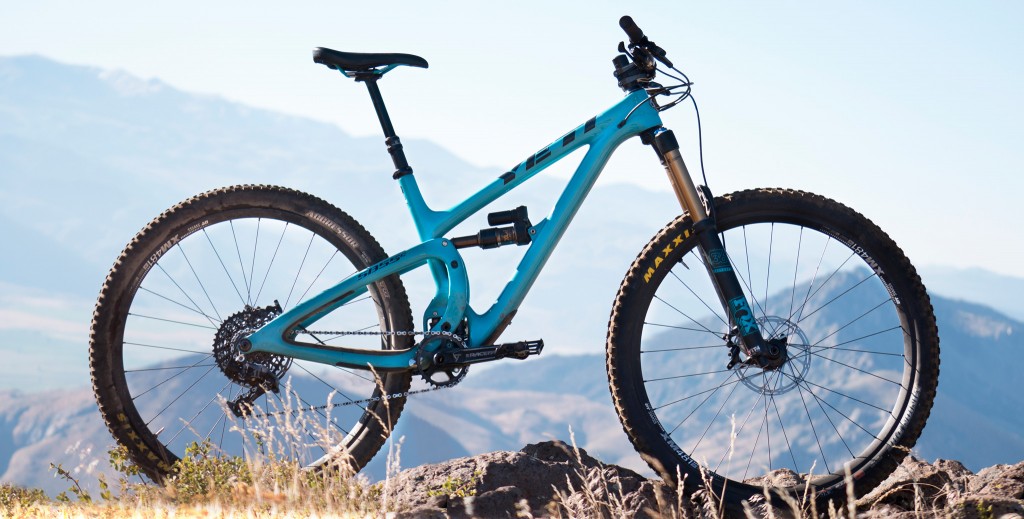Yeti SB5.5C X01 2016 Review
Our Verdict
Our Analysis and Test Results
We spent two months racing the Yeti head-to-head against the stomping 2016 Santa Cruz Nomad, spritely 2016 Ibis Mojo HD3, 2016 Pivot Mach 6 and 2016 Specialized Enduro, to find out which is the best enduro mountain bike. We used a testing process a year in the making. Our protocol requires both long-term riding and intensive testing. We put hundreds of miles on the bikes and racing them against one another in methodical time trails. The courses are carefully selected to rigorously test downhill and uphill enduro skills.
Best Applications
The Yeti is hands-down the best option for those epic adventure days. No other enduro bike in our test offered its compelling combination of solid downhill performance and stellar climbing skills. And it's comfortable cockpit helps sustain the stoke. The Yeti is the only 2016 enduro test bike that any of us would take from this test as the coveted quiver of one.
Downhill
The SB5.5c is incredibly effective in the downs but in a different manner than our favorite descender in the test, the Santa Cruz Nomad. Instead of relying on a long and low geometry with an unshakable suspension like the Santa Cruz, the Yeti has big wheels. Those 29" tires decrease the angle of incidence for any given obstacle. It's a difference that we could feel. When we hit the ground at the bottom of the long rock slab on our downhill course, The Scorpion, it was less “thou shalt not pass” kickback and more “roll along little doggy” friendly.
But, while the Yeti is just as capable as the Santa Cruz Nomad on the downs, it's just not quite as much fun. Those massive wheels mob through everything, but the somewhat stiffer suspension and steeper head tube don't hand it to you like the slack and stable Santa Cruz. Those big heavy tires also keep it from being as playful at speed.- -Speed--
Completing the downhill course, The Scorpion, in an average of 3 minutes and 34 seconds, the SB5.5c was the fastest bike in our tests, by far. On average, the Yeti outruns the last place Pivot by 5.8 seconds, the Specialized by 5, the Ibis by 4.5, and the Santa Cruz by 2.5 on our downhill course.
Those are some pretty solid separators on a 3.5-minute course, allowing the Yeti to gain 1.6 seconds per minute on the Pivot, 1.4 on the Specialized, 1.2 on the Ibis, and 0.7 on the Santa Cruz. If you took the Yeti instead of the Pivot on an hour-long course, you'd finish it 1:36 min:sec faster. That might be enough to beat one of your just slightly faster friends. It's a speedster, but, as most would expect of a 29er, one that's little sluggish out of the gate. It takes four or five strong pedal strokes to get this bike rolling. Because of this, it can feel lumbering at first, obscuring the speed. But after a few runs, and glances at the stopwatch, we realized that we'd just been flying.
It doesn't take long after that to recognize the bike's overall speed. It screams through straightaways and seems to continually gain speed, even through chunky rocks, like it will go on accelerating forever. Few sections were long and straight enough for us to feel that we'd topped the Yeti out. When we did, it didn't back down, cannonballing down the hill. Hoping straight off a 27.5er onto this monster, we often motored into turns and jumps jalapeno hot, resulting in some spicy rides and awesome times — measured in seconds and smiles.
Confidence
Your trail confidence will get a boost knowing that your bike's not going to hold you back. You can monster truck roll over nearly anything, and you've got one slick looking ride. But the real game changer here is that your keep-up-ability just hitched a ride on a rocket. This is the one bike in our test that might give you enough of a speed advantage to help you catch up with, or even beat, those slightly faster friends. It's the only bike that got us anywhere close to our lead tester's times. That'll give you a little swagger.
It might take a minute to take advantage of this capacity for speed. While just as capable, the Yeti is just not as confidence inspiring as the Santa Cruz Nomad on the technical descents. The head tube angle is a degree and a half steeper — more in line with the Ibis Mojo HD3 — and the suspension less supple. It's not enough to rattle you offline or force you off the back of the bike, but it's a step back from the Santa Cruz Nomad ride we love so well. You've got to build your confidence with this bike. But don't worry, its steady performance will earn your trust eventually. At that point, your confidence will soar, a result as the Yeti's control and stability. Then just let it fly.
Handling
Unless you're big enough to confidently flick an actual Yeti (a.k.a the abominable snowman), you're not going to flick this one. The beast responds promptly to directions, but it's no flickable Ibis, quick turning Pivot, or even a plays-well-at-speed Santa Cruz. “27.5 anything is a little more playful,” says our lead tester. “You can launch them a little easier and you don't have to concentrate as hard,” he continues. “But this thing charges.” He's our most wrangle prone rider, and enjoys tossing bikes around by the bars. As such he still found the SB5.5c's handling to be “super nimble, super fast,” just less so than the other bikes. As another rider put it, “for a 29er it feels very nimble, but it's still a 29er.”
The Yeti's handling is responsive. Those uber wide handlebars give you plenty of leverage, and the boosted axle translates to very direct steering, getting that front tire right on track. It's a well-behaved bike, but, while it initiates a maneuver on command, it takes a while to get both those big wheels around to complete it. As such, we needed to be extra aggressive about pointing those bars where we wanted them or had to initiate our moves earlier on the trail.
Once you get it where you want it, the Yeti is stable and balanced. It just doesn't flinch. Our lead tester felt more comfortable launching this bike off big features than any of the 27.5"s save the Santa Cruz, and it's a pretty close match. And, while you might want to pick your way around obstacles on a quick turning, stiffer suspension bike like the Specialized Enduro, the Yeti just rolls over them. “Unless it's' a really big rock, you just keep pedaling through it and over it,” says one tester. It smoothes out the trail, which is great for speed, but if you love popping off all the little features along the way you might prefer the Santa Cruz if you like high-speed technical trails, or the Ibis if you're on the slower side. While it can roll over anything, that sluggish acceleration can make it challenging to get your momentum back when climbing up and over rocks in the way. Once you're back at speed, you'll make up time fast.
It tracks well through it all, especially at race pace. So you won't get knocked off your line, but you might find yourself off route due to the bike's surprising speed and that slightly slower maneuvering. We got 29ered a few times. The Yeti SB5.5c handles better than any 29er we've collectively known, but we still flew off a few corners and trail edges, often because we'd never reached the turn that fast. This was mostly a problem early on, or if we'd just jumped off a 27.5" ride. But, since this bike handles so well and eats chunder all day if you're offline on Plan A, you've got a Plan B — correct it — and a Plan C — roll over whatever you've gotten yourself into. This bike was as good or better under pressure than any other bike in the test.
Recovery was equally opportune, the neutral body position and roomy cockpit made it easy to move around on the bike. If you end up too far back, forward, or to the side, it's easy to recover. If you do find yourself balancing on the bars, it's not a big deal. The Yeti's solid front fork will track, unlike the Santa Cruz Nomad, whose front wheel can flop when you're handlebar-standing, tossing you one way or the other without warning.
Suspension and Traction
“It can definitely handle the rough and rowdy stuff but it's not as plush as the Nomad is,” sums up one tester. For a shorter travel bike (5.5") it felt phenomenal and maintained a ton of traction. The tires provide the majority of the trail smoothing effects on the small hits, the travel kicks in on the big ones. In contrast, the Santa Cruz Nomad relies more directly on the suspension.
Early in its stroke, the Yeti feels similar to the stiffer early strokes of the Ibis and Pivot, though the big wheels reduce the chop. Then the suspension opens up to take big hits nicely. Surprisingly, our lead tester found the Yeti bucking on two square hits in the fastest line on the downhill course, The Scorpion. Whereas the Santa Cruz created a ramp out of its suspension and sailed over those same hits, the Yeti had some serious kickback. We would have expected those big wheels to do better. Possibly the Santa Cruz's slacker head tube angle pointed its fork more directly at the rock, allowing it to soak in the feature while the tucked in tire of the Yeti sent it back through the frame. This was a pretty isolated issue.
Our lead tester describes the boosted Fox 36 Factory fork on the Yeti as “da bomb.” And there's plenty of room for that big wheel to travel. Between this and our very favorite front end, the boosted Rockshox Pike RCT3 on the Ibis, we're sold — boosters, for sure. The chatter-free smoothness of the Yeti's fork, made the bike feel very similar to the Ibis, but with a better backend. Unfortunately, it's a huge pain to change the rebound settings on the very nestled Factory Fox Float X rear shock.
Between the active suspension system and the excellent tire combination of the Maxxis Minion DHF 2.5" in front and Aggressor 2.3" in the rear — traction was excellent, very similar to the unrelenting traction of the Santa Cruz Nomad.
Climbing
The Yeti combines the upright, aggressive climbing feel of the Pivot, Ibis and Specialized, with the monster truck rolling skills of the Santa Cruz. It's the best performing bike in our climbing benchmark tests and a bike that can hold it's own with any all-mountain bike, whether trail or enduro oriented. As we explained in the downhill section, the Yeti smoothes out the trail, and we found the same to be true uphill. Compared to the competing bikes with 27.5" wheels, the Yeti's 29ers roll over uphill technical climbing challenges — whether it be stair steps, baby heads, or sustained rock gardens — with relative ease. It is noticeably easier to clean trails on this bike, even at slower speeds. Instead of working through the steps with an artful line, you just pedal over them. We'd reach the top realizing that we hadn't changed the pedaling cadence once on the entire climb. As one tester puts it, “trail obstacles become less, obstacle-y.”
“Surprisingly, in those tight steep corners, it does really well,” says one tester. “It feels very efficient climbing.” You're not losing a lot of power to the rear suspension, and you're not wasting a lot of energy moving around on the bike to push and pull it through technical stretches. Your body position remains neutral in the saddle as the bike's excellent traction saves you from having to shift around searching for it. All you have to do is stand up and crank, possibly shifting a hair rearward to prevent tire spin, and then sit back down — efficient. It steamrolls. You don't even have to do that often, one rider estimated that, on the technical climb, he was out of the saddle only about 10% of the time, standing up only to maneuver around technical corners.
We ranked it highly because it's great, but it's not perfect. It's the heaviest bike in the test. Some of that extra weight is in the wheels and has a disproportionate effect on acceleration. So it makes sense that it's slow to get rolling before gaining speed like crazy. After those first, momentum-making pedal strokes, climbing in the saddle feels great. At lower grades you feel like you could spin along forever, rolling much faster than the Santa Cruz Nomad, but it's harder on steep stairs. Accelerating through the punchy climbs can leave you gassed. We struggled to keep momentum up and over the rocks and it took fitness to accelerate at the top of the stairs. But, again, mashing on the pedals once you reach a mellower grade gets you right back to speed.
Speed
The Yeti smoked every other enduro bike in our uphill benchmarking time trials, conducted on our designated race course, The Soul Grinder. And not by a little, by a lot. On average, the Yeti SB5.5c completed the course in 2 minutes and 10 seconds. That's a 6.4 second gain on the Pivot Mach 6, a 5.9 gain on the Ibis Mojo HD3, and 3.8 lead on both the Specialized Enduro and Santa Cruz Nomad.
These numbers are pretty definitive, translating to a 2.9 second per minute gain on the Pivot, a 2.7 second/minute lead on the Ibis and a 1.2 second per minute advantage over both the Santa Cruz and the Specialized. That means, that on a ride that takes an hour, the Yeti will be cooling its jets for 1:42 min:secs before the Specialized or Santa Cruz arrives.
Though it's slow to accelerate, you'll make up plenty of time carrying speed on the flats and over the rock chunder. We felt like this bike coasted more than the others, going fast and holding speed without any effort.
Pedaling
The Yeti pedals great, aside from those first three or four laborious strokes — still, quick for a 29er. The cockpit is relatively relaxed, similar to the Santa Cruz Nomad. But we all agree that the Yeti sets you up in a more aggressive, and more comfortable, pedaling position. When you're in the saddle, you're golden. Spinning uphill on a moderate grade feels good enough to boast about. ("All day!")
Getting out of the seat to conquer a steep stretch works well too, at speed. You'll roll right over everything. But the longer this goes on, the more speed you'll lose, and the harder you'll have to work. Accelerating at the top of a pitch isn't easy. It's a grind to bring it back, leaving our lead tester gassed. But, when the grade mellows out, if you just sit down in the saddle and crank on the pedals, you'll start making up time quickly. “Once you do start accelerating, the thing is going and it's kinda scary to continue pedaling,” says our lead tester. Like driving a drag race car, “it charges in a straight line extremely fast.” And it maintains that speed very well. But all straight lines end, and you might find yourself with more speed than you want coming into that inevitable turn.
The compression locked out nicely, with less bounce than the Santa Cruz, and pedaling feels efficient with compression settings in open, trail, or closed modes. This is also the only bike in the test that didn't have a significant pedal strike issue. Meaning you can almost always be putting power into the pedals, and your speed.
- -Handling--
Even when smashing over everything in sight, in a manner similar to the Santa Cruz Nomad, the steering doesn't flinch — no fighting this front wheel. We think it handles better climbing than the Santa Cruz because of that. There's no Nomad-like tendency for the front wheel to flop when you get over the bars, but the 27.5er is still easier to work around tight corners. However, the Yeti's steering is good enough that, if you want, you can also pick your way around obstacles instead of mobbing over them, #options.
The Yeti handles best when you're centered over the bike, shifting a smidge rearward to keep traction on the rear wheel when climbing stairs. We tried pedaling off back, and the front wheel drifted over the front, and the rear tire lost traction. Stick to the middle.
Suspension and TractionAs we've mentioned, the Yeti's suspension is not as plush as the Nomad's, and you can feel it on the climb too. While it plows right over rocks regardless, you do feel the junky chop more, making it a ride akin to the DW-link system on the Ibis or Pivot. But a bit smoother, owing to those big 'ole ties.
It's a great suspension setup for pedaling and traction. “It just doesn't feel like there's a lot of nonessential movement going on with the rear suspension,” says one tester, so you don't waste any energy. This well-designed suspension platform maintains good purchase on rocks, including steep and loose gravel sections, while climbing. You don't lose traction in open mode or trail compression settings, even over rough staircases. The lockout was too much to maintain traction on the technical section but worked great on our paved climb tests.
Cornering
The SB5.5c is surprisingly good — nearly nimble — at slow speed cornering, even on really tight turns. Generally, corners this slow are taken on the uphill. Once you hit speed on the descent, the additional momentum makes things interesting in a hurry. It corners, but you can't get lazy about turning this bike. There are no (tossing or flicking) shortcuts. The Yeti is well-balanced, but its methods of getting around tight turns or long, fast berms take some getting used to. “I've ridden a lot of 29ers and this thing, for a 29er, is quite nimble around corners but it still feels like a 29er to me.”
For this reason, our testers found the Yeti to be below average when it comes to cornering. Competing bikes like the Specialized Enduro, the Ibis Mojo HD3, and the Pivot Mach 6, are all more adept. Even the slack and long Santa Cruz Nomad is more versatile in the turns.
Most 29ers have a reputation for being bad at taking sharp, flat turns; the Yeti SB5.5c is only a partial exception. It's a little better than your average 29er, but you've gotta be on top of your cornering game — start early and confidently commit. At speed, you've really got to lean it over. Handlebar turns won't get you around the corner before you're past it and into the bushes (if you're lucky). One tester shifted forward to keep the front tire from washing out around the flat turn, another dumped the bike over aggressively, letting both tires drift, before smacking the corner. Everyone found their own way around, but we were all heads up.
In long sweeping turns, the Yeti wants to stand up. Those bigger wheels have more angular momentum — meaning that when the wheel is spinning straight up and down on its axle, it wants to stay that way, and will resist laying over. This is a physics law known as the conservation of angular momentum. The bigger the wheel, the further the weight is from the axles, the more leverage that weight has, and the greater its tendency to conserve angular momentum (i.e. stand back up) will be. This is often referred to as a gyroscopic effect, as it is one of the principles exploited by gyroscopes.
If the wheels do stand up, you're no longer turning the bike, and it heads for the outside of the corner. You have to really aggressively lay it over to fight past the bike's self-righting tendencies, which can feel intimidating since you're higher up than on the other bikes in the test. This is a hard move for new, or even timid intermediate riders. Technique, commitment, and confidence are the game. Once you find just the right balance of dumping the bike into the turns without tipping over, you've got cornering traction for days. The tires hook up really nicely, and, it's gravitron level fun — nice and snappy out of turns, due to a bit of flex in the rear end. It feels light popping from berm to berm with gobs of tire traction.
The Yeti shines in smooth, mid-sized corners, where you have room to lean the bike around the corner but it doesn't have to be at such a severe angle. These you just rally through. You've still got to be aggressive, but when you are, the bike rails around.
Turning this bike is a little slower than the others in the test. One tester found that initiating turns earlier allowed for a mellower cornering approach. If you lose speed maneuvering through the turns, you run smack into that whole sluggish acceleration thing like a 5' thick wall of Jello, that you then have to pedal through. Be prepared. Instead of bashing it out in a harder gear, drop it down and hammer out of that corner.
Fun Factor
The Yeti SB5.5c is a different kind of fun than a smaller, livelier bike like the Ibis Mojo HD3 or the plush, chunder-mobber Santa Cruz Nomad. Where the Ibis jumps up, the Yeti launches straight off, holding its original trajectory and speed. And whereas the Santa Cruz offers a luxuriously smooth ride that's still playful at speed, the Yeti keeps a business first, maintain momentum at all costs, attitude. But you get everywhere faster, especially up those not so fun climbs, leaving you with more time and strength to put in as many miles as the day has hours for.
Those big wheels go a long way towards smoothing out the rougher edges of any trail. Of course, that can work against the bike too. Making every trail feature relatively smaller can almost remove them on mellower trails, possibly glossing over your everyday ride. In contrast, you feel the features, and all their accompanying fun, on the Santa Cruz Nomad, just not the jolting shock of impact. Even so, we'd take the consolation of wickedly fast runs any day.
Jumps“You have to be careful with this thing when descending flow trails because it just wants to charge,” says our lead tester. Landing park jumps right in the transition zone is a frightening prospect as the Yeti accelerates perfectly back out of them. It wants to go five miles an hour faster than you're ready for. “I over-cleared jumps that I normally don't on this thing, and it took it all really well,” continues the lead. “In the air, jumping it's probably the most stable 29er I've ridden yet.” He felt more comfortable launching off big features than on any other bike aside from the Santa Cruz, and it's a pretty even match. No bottoming out here.
Race Factor
The Yeti literally leaves the other bikes we tested in the dust. It was no contest on both our uphill and downhill race courses versus competing bikes. The Yeti crushed it, gaining a combined advantage on the up and downhill test courses of 12.2 seconds over the Pivot Mach 6, 10.4 over the Ibis Mojo HD3, 8.8 seconds over the Specialized Enduro Expert, and 6.3 seconds over the Santa Cruz Nomad.
That gives the Yeti a gain of 4.2 seconds per minute over the Pivot, 3 sec/min over the Specialized, 3.6 over the Ibis, and 2.2 over the Santa Cruz. So, assuming an hour-long course, the Yeti will be sitting at the finish line for a full 2:12 min:sec before the second place Santa Cruz arrives. Pretty Racy.
Build
“They did a really great job specing this,” commented our lead tester at the bike build meeting. Heads nodded. We rate it an 8 of 10, one point below the 9 rated Santa Cruz Nomad. It fell a point below the Nomad because the front rotor leaves the brakes just adequate for the speeds this bike hits and a there's no chainguide to keep it rough and enduro-ready.
Cockpit and Fit — To the uninitiated, climbing up on the Yeti and stretching your arms out to the end of the bars can feel like a time warp that finds you saddling up your Dad's ride back in the day. It's not always a bad thing, “I kinda like that more commanding position sometimes,” says one tester. (If you're new to 29ers, expect everything to feel normal in relation to the pedals, your feet are just going to feel much higher off the ground.) And it's comfy — with a great seat choice and “superb” cockpit that keeps you in a pretty neutral position, especially compared to the more rearward positioning on the Santa Cruz and Specialized. The frame fits all of us, ranging from 5'7" to 5'10", but it runs large.
Frame and Suspension —The combination of this rear shock and suspension system lets our heaviest, most aggressive rider, i.e. our lead tester, blow through the travel too quickly unless he really goes crazy with the air pressure. He has to pump it up to 205 psi. This works, but a heavier or even harder hitting rider might bottom out. Our other three, lighter, testers ran pressures comparable to the other four bikes. This weight/riding style based split is due to the relatively flat leverage ratio curve of the Yeti SB suspension system and the increased air volume of the Extra Volume (i.e. EVOL) Fox' Factory Float X shock. The Yeti's SB system relies on the rear shock to progressively stiffen up as it moves through its travel to slow suspension use. But the newer shocks, with their extra air volume, are less progressive than older models, this improves their performance on small bumps but makes it easier to blow through the entire travel. They now rely on volume spacers to decrease volume and make the system more progressive. Our lead tester could have used one on the Yeti. It's a simple fix, but not one we were performing on any of our “as built” bikes.
Wheels and Tires — The boosted wheelset works nicely — we're sold on the stiffening properties of a boosted axle for a 29er ride. The DT Swiss 350 W/XM481 wheelset is also a solid choice for enduro riding.
The Maxxis tire combination, a Minion DHF 2.5" on the front and an Aggressor 2.3" on the rear, is great, feeling extremely grippy. The burly front tire cornered well and worked great in sand, while the back tire balances fast rolling function with sufficient traction. But, when things turned uphill, the ramp angle knobs on the rear tire slide out when accelerating on loose dirt. Both tires have fairly stiff sidewalls, increasing durability, and weight. The combination of added weight and increased rolling resistance might be a bit much on that front wheel at times. A 2.3" may be plenty for nice loamy soils.
Sadly, there is no chainguide. While the clutch rear derailleur supposedly doesn't need one, a couple of us have still lost time, and podium places, to thrown chains. We also lost the chain on the Pivot Mach 6 during testing, twice. We just really love the extra piece of mind a chainguide provides.
While the 180mm rotors worked pretty well because of the excellent traction the bike maintained, we'd still feel better going up a full size to 200mm in the front. This bike is so fast that more braking power is always appreciated.
Handlebars, Seat and Seat post — The 800mm handlebars felt wide but helped wrangle the big wheels well. Shaving them off to 780mm might help to get through the trails with tight trees while maintaining plenty of control. The SRAM reverb dropper post works well enough to take for granted and the Yeti WTB saddle is comfy.
Value
At $6,999 it's the most expensive bike in the test, but it's also the most versatile. And the Yeti has a very nicely curated, high-end build, with an Easton Havoc, handlebar and stem, upgraded brake shifter, solidly enduro wheelset, and good tires. “It's a lot, but you get a lot of bike for that money,” said our lead tester. We'd take it enduro racing. We'd take it all day mountain riding. We'd pick it for a speeding spin through the foothills or city parks. We know we'd never be shortchanged when road tripping for those big mountain lines. This could be your everything bike.
That's why it earned our Editors' Choice Award as the Best All-mountain Enduro Bike.
Conclusion
The Yeti SB5.5c is an incredible bike, an obvious Editors' Choice. It can take everything you throw it at, and we threw a lot. It's so fast and efficient that you can test it out on more miles than you're used to. This a machine that can handle your biggest dreams (e.g., traverse ridge lines, mountain ranges, continents) and your local rides. Just find a comfortable method to get you through the sharp and extra wide turns and can adjust to its dirtbike-like speeds, and you'll be unstoppable.


